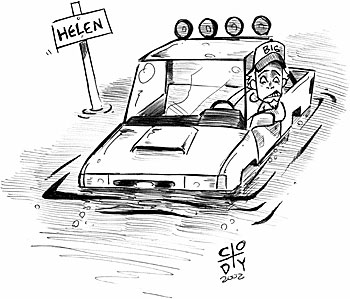
Illustration by Cody Angell
|
By Kendrick Wilson
Arizona Daily Wildcat
Thursday September 26, 2002
Rain in the desert. Everyone runs to windows and feels obligated to announce, "It's raining!" I'm not personally a fan of overcast days, but it's hard to deny that the desert needs the rain.
Unfortunately, rain also brings flooding. Anyone who remembers the tail end of this year's monsoon season remembers wading through water ÷ in some cases over a foot deep ÷ all over campus.
The problem of flooding in central Tucson is not new. In fact, it's as old as the neighborhoods surrounding the UA.
When the university area, along with the rest of central Tucson, was developed, riparian area was a term that simply didn't exist, and flood control wasn't seriously considered.
So, here we are, with all-too-few storm sewers, all-too-many diverted or filled natural washes and floodwater running rampant through the streets.
It's hard to imagine what the Tucson valley must have looked like 100 years ago before all the development. There was a time when the Santa Cruz River zigzagged across the valley as a ribbon of blue water. But those days are gone, as the bulldozers and water wells have had their way with the valley.
The developers, in their infinite wisdom, often miscalculated flood potential ÷ or simply didn't care ÷ and washes that were diverted were often channeled through man-made waterways that are easily overwhelmed by the volume of water produced by our summer monsoons.
Many washes were simply filled, turning streets into raging rivers every time it rains.
Before construction of a multi-million dollar storm sewer on Alvernon Way in the early 1990s, Tucsonans commonly referred to the "Alvernon River" and reminded friends and neighbors to avoid it during storms. Streets in Sam Hughes, Rincon Heights, Iron Horse, Pie Allen and West University neighborhoods surrounding UA often flood today and have even been known to stall a few almighty SUVs. Anyone who doesn't believe it should take a drive down Forgeus, Sawtelle, Plumer or Helen during a torrential rain ÷ and make sure to pack a snorkel!
This year, flooding in the parking lot between La Paz Residence Hall and the football stadium was so bad that few cars could drive through. Many students took off their shoes to wade through muddy water containing a few visible hypodermic needles, along with an array of other litter floating around.
Fortunately, the same mistakes are not being made with new development in Tucson. In the late 1980s, when former City Council member Janet Marcus was first elected to office, one of the biggest and most controversial issues was a proposed Wash Protection Ordinance. Marcus supported the ordinance, and it eventually passed. Developers would finally be required by the city to leave natural washes and other waterways intact, developing around them instead. Undoubtedly, many developers have lost profits, but the results of the ordinance have been remarkable.
Neighborhoods built after the ordinance was enacted don't have flooding problems like the UA and central Tucson. In fact, areas with protected natural washes hardly ever flood. In addition to flood control, unique riparian ecosystems have been protected, providing open space, even in highly developed areas. Natural washes have been shown to provide urban habitat for a number of native birds that would otherwise be driven to the foothills, not to mention the elusive desert spade-foot toads.
Indeed, it is sad that Tucson's leaders did not have the foresight to protect the native washes when the UA and surrounding neighborhoods were built. Imagine an inner city with natural open space every mile or so, places where children could play and come in direct contact with their natural environment. Such an inner city would not flood as badly when it rains.
Unfortunately, the natural washes around the UA are all gone, either replaced by concrete storm sewers, re-channeled waterways or simply filled with dirt. Along with them, the unique habitats and the only effective way to quickly move floodwaters from the area have also disappeared.
The next time you grit your teeth as your car goes through a puddle the size of a lake at Park Avenue and University Boulevard, wade through the stadium parking lot being careful to avoid the hypodermic needles, or try not to become soaked as you cross Sixth Street after a rainstorm be sure to thank the developers. Neighborhoods with protected washes have proven it doesn't have to be this way.

